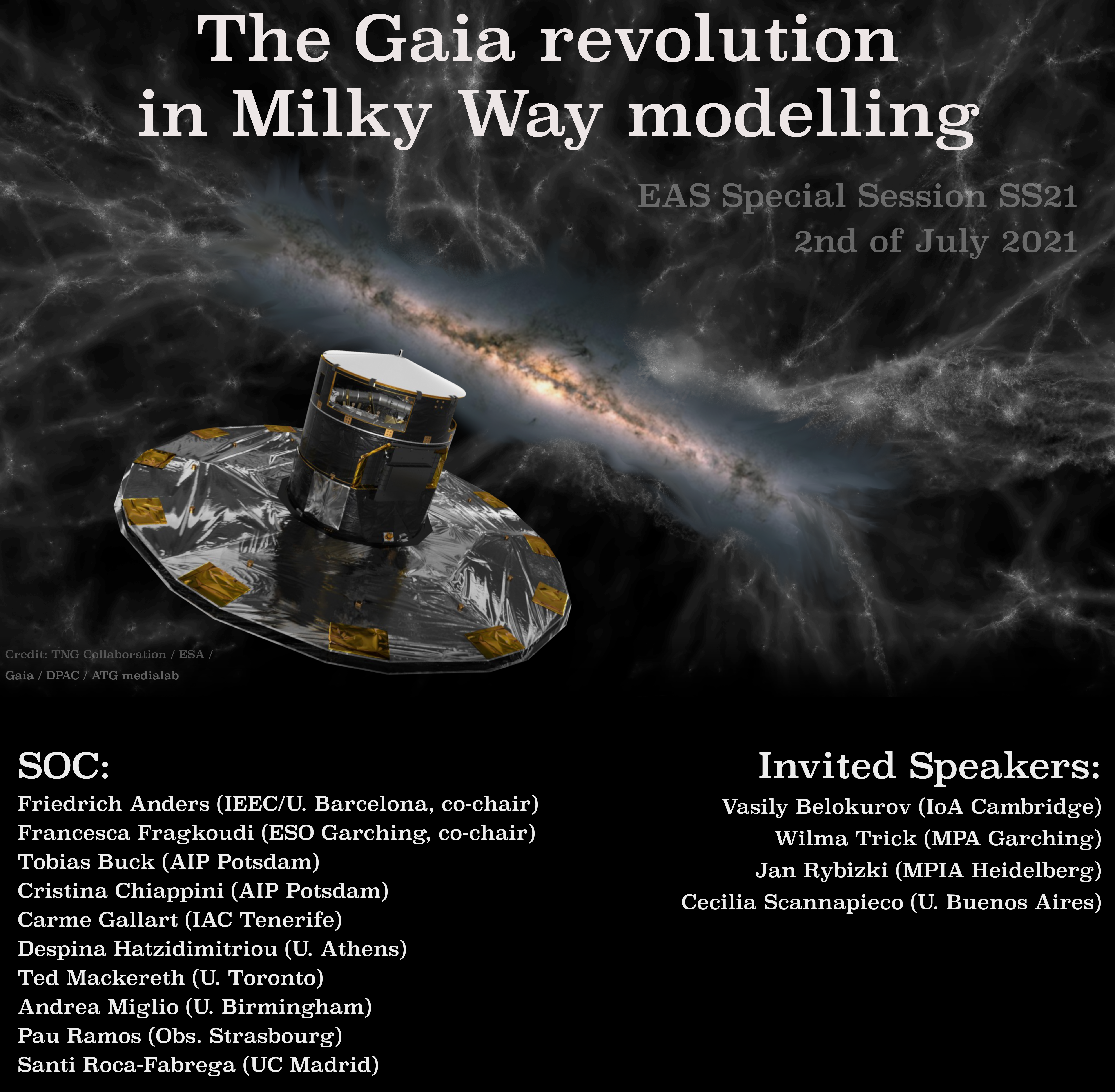Special Session SS21
2 July 2021
The Gaia revolution in Milky Way modelling

News:
Programme is ready; registration for EAS is still open!
Aims and scope
The Gaia star census of the Galaxy, enhanced by current and future multi-object spectroscopic surveys like APOGEE, RAVE, LAMOST, GES, WEAVE, 4MOST, SDSS-V, or MOONS, is revolutionizing our understanding of the formation history of the Milky Way. Similarly, state-of-the-art (zoom-in) cosmological simulations have recently reached sufficiently high resolutions to understand the processes shaping galaxies in details. But the mere existence of these large datasets and high-resolution simulations is insufficient to ensure a major knowledge gain about the formation and evolution of our Galaxy. Many datasets are subject to non-trivial selection effects, systematic uncertainties (especially for ages of field stars), and correlated errors that impede straightforward conclusions and affect simplistic model-to-data comparisons.
There is now an urgent need for more quantitative comparisons of Gaia observations to state-of-the-art Milky Way models and clear indications where such models should be improved. Also, there is still a lack of publicly available software that facilitates these complex model-data comparisons for the theoretical as well as for the observational community. What are the most important implications for the next-generation models of the Milky Way, from N-body, chemical-evolution, dust, and population-synthesis modelling to cosmological zoom-in simulations including complex baryonic physics?
The data-driven Galactic community is converging towards a framework that allows to determine both the Galactic star-formation history and the stellar mixing rate as a function of time and position in the Galactic disc from astrometric, spectroscopic, asteroseismic, and photometric observations. Additional, more precise data both from Gaia EDR3 and DR3 (scheduled for early 2022) as well as from upcoming spectroscopic surveys and asteroseismology missions will contribute to an improved, comprehensive picture of the formation and migration history of the Galactic disc. This Special Session will invite the Milky Way modelling communities (especially early stage researchers) to present and discuss their science highlights, especially focussing on novelties brought about by Gaia EDR3.
Programme
- Most pressing questions in Galactic Archaeology & Milky Way modelling
- Chemo-dynamical Modelling of the Milky Way
- Isolated & Cosmological N-body Milky-Way simulations
- Publicly available software & mock observations
Invited speakers
- Vasily Belokurov (IoA Cambridge)
- Wilma Trick (MPA Garching)
- Cecilia Scannapieco (Universidad de Buenos Aires)
- Jan Rybizki (MPIA Heidelberg)
Scientific organisers
Friedrich Anders (IEEC/U Barcelona, co-chair)
Francesca Fragkoudi (ESO Garching, co-chair)
Pau Ramos (Obs Strasbourg)
Ted Mackereth (U Toronto)
Carme Gallart (IAC Tenerife)
Tobias Buck (AIP Potsdam)
Despina Hatzimdimitriou (Univ Athens)
Cristina Chiappini (AIP Potsdam)
Andrea Miglio (U Birmingham)
Santi Roca-Fŗbrega (UC Madrid)
Contact
fanders[št]fqa.ub.edu, francesca.fragkoudi[št]eso.org
Updated on Tue Jun 01 13:47:52 CEST 2021
|